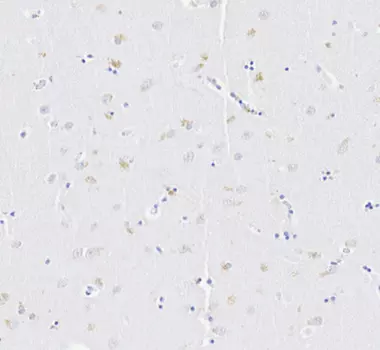Cinnabarinic acid Antibody – Mouse Monoclonal
Ref: IS005
Kynurenine pathwayTryptophan metabolismMonoclonal AntibodiesICCIFIHC
 +
+Cinnabarinic acid detection by IHC in human breast tumor
Immunohistochemical staining of human breast tumor tissue shows presence of Cinnabarinic acid in cells surrounding a necrotic area. Paraffin-embedded tumor tissue was subjected to pH=6 antigen retrieval before overnight incubation with primary anti-Cinnabarinic antibody (1/500 dilution). A polymer-conjugated secondary Ab was added and immunostaining was revealed using DAB.
DatasheetMSDS
The first and only validated anti-Cinnabarinic acid antibody available for research use. IHC validation of this mouse mAb in human brain and breast tumor tissues revealed the presence, in specific cells, of Cinnabarinic acid, a tryptophan metabolite known for its immunomodulatory role. A 2020 paper also used this anti-cinnabarinic antibody to stain mouse brain tissue sections (immunofluorescence).
| Clonality | Monoclonal antibody (clone 5C5-E10) |
| Host | Mouse |
| Valided applications | IHC & IF |
| Reactivity | Reacts with all species |
| Format | 50µL |
| References | Cited in 1 paper |
| Size | 50µL |
|---|
449.00€
97 in stock
Worldwide shipping
Product overview
| Product name | Cinnabarinic acid antibody |
| Synonyms | 2-amino- 3-oxo- 3H-phenoxazine-1,9-dicarboxylic acid antibody |
| Immunogen | Conjugated Cinnabarinic acid |
| Isotype | IgG1 k chain |
| Clone | clone 5C5-E10 |
| Specificity | When tested in competitive ELISA, the anti-Cinnabarinic acid antibody 5C5-E10 did not cross-react with its precursor, 3-OH-Anthranilic acid conjugates |
Storage
| Form | Liquid |
| Purity | Purified IgG |
| Concentration | 0,5mg/ml |
| Storage |
Store at +4°C for short term (6 months). Aliquot and store at -20°C for long term. Avoid repeated freeze / thaw cycles |
| Material safety datasheet | Download MSDS |
| Immunohistochemistry (IHC) | Dilute at 1:200-1:2000. Perform heat antigen retrieval (pH=6) before initiating IHC staining protocol on paraffin-embedded and frozen sections |
| Immunofluorescence (IF) | Dilute at 1:100-1:1000 on paraffin-embedded and frozen sections. Perform heat antigen retrieval and incubate with fluorescent secondary antibody conjugate |
| Comments | Optimal working dilutions must be determined by the end-user |
| Restrictions | For research use only |
Product citation
- The Trace Kynurenine, Cinnabarinic Acid, Displays Potent Antipsychotic-Like Activity in Mice and Its Levels Are Reduced in the Prefrontal Cortex of Individuals Affected by Schizophrenia
Check the article
Authors : Ulivieri et al., Schizophrenia Bulletin
2020-12





